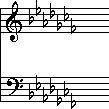|
|
Battle Ends And Down Goes Charles' Father or BEAD Greatest Common Factor (for those who don't rhyme) |
The first letter of each word in this sentence tells us the order that the flats are entered in a key signature: first the 'B', then the 'E', the 'A', and finally the 'D'. It looks like this, in both clefs of the Grand Staff:

A key signature that uses all seven possible flats will look like this:

The neat thing about the "Battle - Ends..." rhyme is that reversing the order of the rhyme gives us the order of sharps in a key signature:
|
|
A key signature that uses all seven possible sharps will look like this:

KEY SIGNATURE HINTS:
There are some little "tricks" that can help you know
which major key belongs to which key signature. Consider this key
signature: You might think this is a rather complicated one to start with, but in
fact it's quite easy if you remember this rhyme:
You might think this is a rather complicated one to start with, but in
fact it's quite easy if you remember this rhyme:
|
When sharps you see, the last is "ti". or The alphabetical letter after the last sharp is the name of the scale. (for those who don't rhyme) |
'Ti', of course, is the solfa name for the seventh note of the scale, the 'leading tone'. (You'll learn more about these technical names in a later lesson.) The last sharp indicated above is the B#. If that's the seventh note, we know that the next note will be the key-note, and it will be one diatonic semitone higher. Therefore, this key signature belongs to C#-major.
Consider this key signature: Now remember this little rhyme:
Now remember this little rhyme:
When flats there are, the last is 'fa'.
or
The name of the scale is the next to the last flat.(for those who don't rhyme)
'Fa' is the solfa name for the fourth note of the scale. The last flat indicated above is the F-flat. If that's the fourth note, we know that the key-note will be four notes lower. Counting down in this key signature four notes, we hit 'C-flat'. Therefore, this key signature belongs to C-flat major.
So here are the rhymes to remember:
|
THE ORDER OF FLATS: |
Battle Ends And Down Goes Charles' Father |
|
THE ORDER OF SHARPS: |
Father Charles Goes Down And Ends Battle |
|
'SHARP' Key Sig. Hint: |
When sharps you see, the last is 'ti' |
|
'FLAT' Key Sig. Hint: |
When flats there are, the last is 'fa'. |
PRE-QUIZ ASSIGNMENT:
Take a piece of 12-stave manuscript paper. Create 4 Grand Staffs), making four measures per system. Then:
a) Write out all the key signatures that use sharps. Label each one.b) Write out all the key signatures that use flats. Label each one.
The first ones have been done for you:

For more practice on major scales and key signatures before you take the quiz, here is a practice sheet with another way of doing major scales (may take time to down load, large gif.). Here is another way of memorizing major scalesand key signatures:
Quiz - Scale Reference Sheet
